 |
Flying High With Electric Power!
The Ampeer ON-LINE!
Fly the Future - Fly Electric! |
|---|
Site Table of Contents
| President: | Vice-President: | Secretary-Treasurer: |
| Ken Myers | Keith Shaw | Rick Sawicki |
| 1911 Bradshaw Ct. | 2756 Elmwood | 5089 Ledgewood Ct. W. |
| Commerce Twp., MI 48390 | Ann Arbor, MI 48104 | Commerce Twp., MI 48382 |
| (248) 669-8124 | (734) 973-6309 | (248) 685-7056 |
 | ||
| Board of Directors: | Board of Directors: | Ampeer Editor |
| David Stacer | Arthur Deane | Ken Myers |
| PO Box 75313 | 21690 Bedford Dr. | 1911 Bradshaw Ct. |
| Salem, MI 48175 | Northville, MI 48167 | Commerce Twp., MI 48390 |
| (313) 318-3288 | (248) 348-2058 | (248) 669-8124 |
| Upcoming EFO Meeting: Wednesday, January 15, 2025 Time: 7:30 p.m. EST
Place: Zoom (See note in this issue.) | ||
| EFO Meeting Reminder Not until January 15 on Zoom. | The November EFO Flying Meeting Ken discusses some beautiful fall flying. |
| More Comments on Flying Field Accidents Vic Madison shares thoughts on how to help prevent electric prop accidents at the flying field. | Change of Email Address Requested Ken suggests keeping your email address up to date with him. |
| Indoor Flying in Brighton Information Indoor Flying Announcement. | Indoor Flying in Pontiac Info Indoor Flying Announcement. |
| 'Tis the Season Ken describes how to power a glow plane picked up at a swap shop. | Upcoming Toledo R/C Swap Meet & Expo Upcoming area event information. |
The eagle-eyed may have noted that this issue is for December AND January. I have never done a two month issue before. I have done two issues in one month, but never one for two months. Until very recently, reader input has slowed to a trickle and I've not had a lot to say. I have no idea whether this will be the only combined issue at this time. The next EFO meeting will be via Zoom on Wednesday, January 15, at 7:30 p.m. EST. EFO members will be sent an email with the Zoom link. If you'd like to join us, send me an email at kmyersefo@mac.com and I'll add you to the meeting notification list. I am planning on a February issue, which will be posted some time after the January Zoom meeting. See you on Zoom in January, Ken Return to "What's In This Issue" The November EFO Flying Meeting
The November EFO Flying meeting was held on Saturday, Nov. 2. The autumn weather was beautiful, with almost no wind to speak of. There was bright sunshine, the temperature was extremely comfortable for the beginning of November here in southeast Michigan. With no wind, very sunny skies and a temperature approaching 60 degrees, it was a super flying day. Denny Sumner got in the first flight with his 4S powered T-28. It's a real goer! There was time for a lot of chitchatting and enjoying each other's company. Everyone brought something to fly, and because of the cool air, the planes performed very, very well. Keith Shaw had a great time flying his highly modified Bantam Bipe. 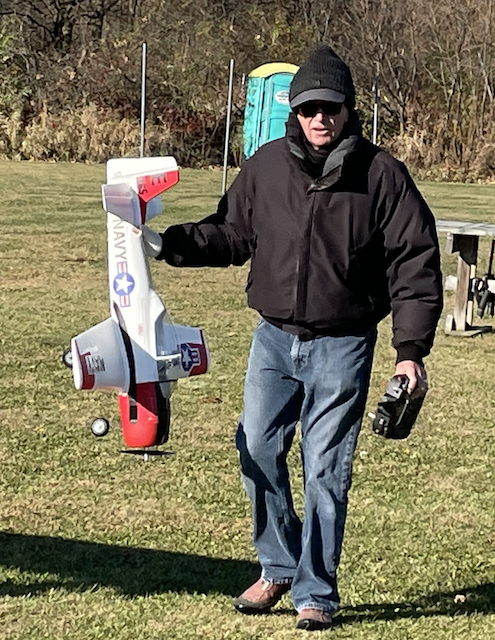 Denny Sumner with his T-28 early in the day. 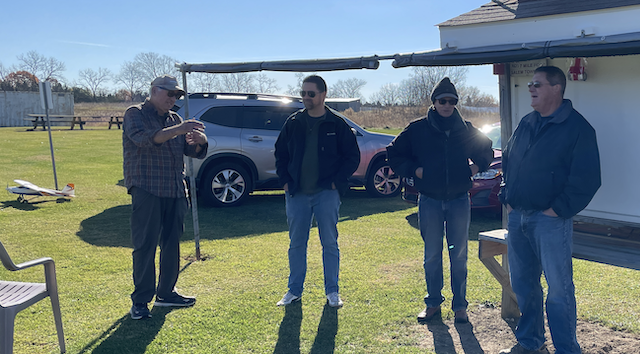 The guys "shooting the breeze", although there was none to speak of. 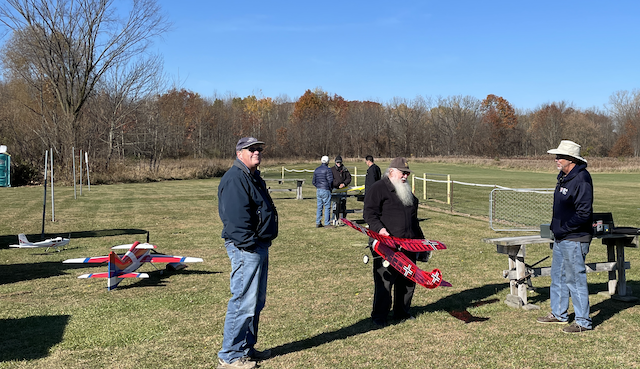 Many types of planes took flight on this wonderful day. 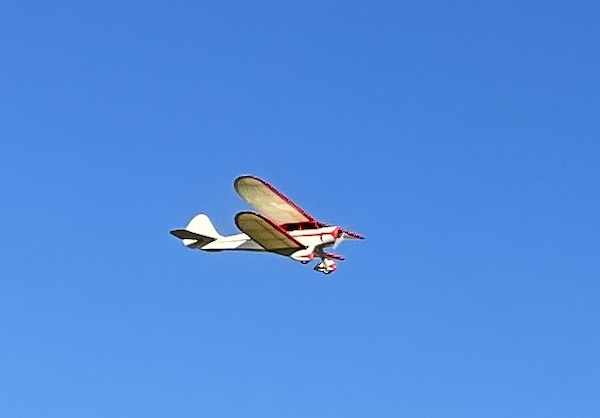 Keith Shaw's great flying, cute SR Batteries, highly modified, bipe. 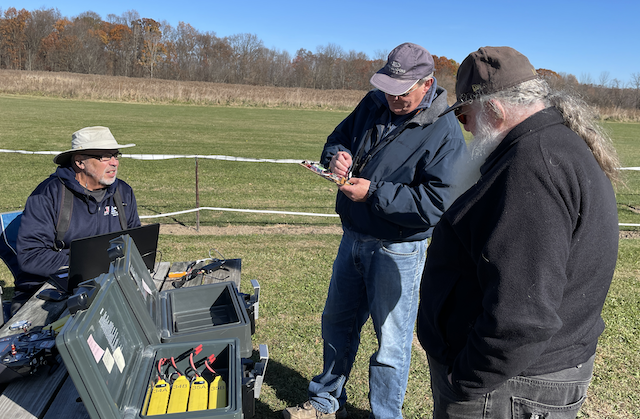 Dave Stacer (center), our electronics guru, showed Keith Shaw his latest electronic gadget. Lynn Morgan (left), is an avid precision aerobatics (pattern) flyer. Part of the flight schedule, of that class that Lynn flies, requires several 45 degree climbs. Dave's gadget includes several components. On board Lynn's plane is a sensor connected to a transmitter that sends back data to indicate when the plane is actually at 45 degrees of climb. A ground receiver picks up the transmitter data, which is then fed into a computer. A program then converts the data into tones. There are tones for angles below, on, and above the 45 degree angle. The tones can be heard on the computer and via bluetooth to a headphone worn by Lynn. It is all very, very slick, and was in the prototyping phase on this day, Of course the device is only used for practice purposes and not when Lynn would be flying in actual competition. All I can say is, "Wow, this is really cool." Aaron Heiner brought back his Pulse. Last month I noted that he'd had a problem. None of us were able to get his Futaba 7C to program a throttle lock. I also noted that we fixed that problem by providing him with a Spektrum transmitter. 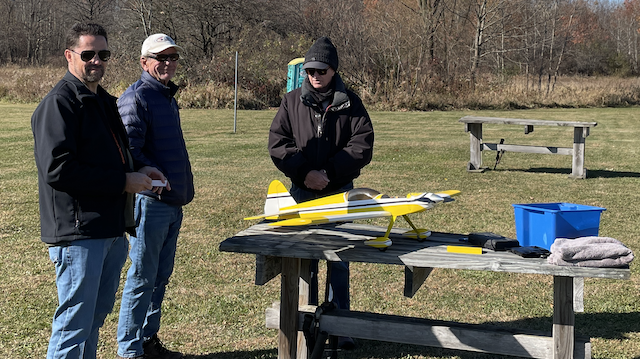 Several folks helped him get that "new" transmitter programmed. 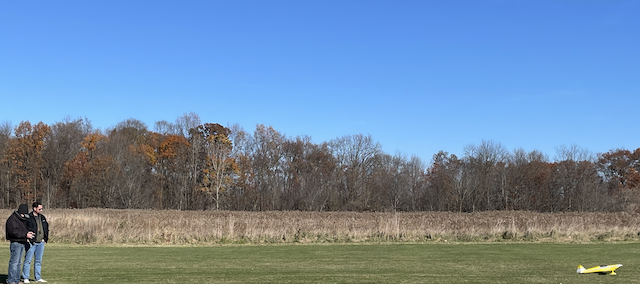 Denny Sumner finally got to take up Aaron's plane for its long anticipated first flight, which was extremely successful. Dave Stacer, Midwest RC Society's head flight instructor, had his student, "Roy", out for some training flights on this perfect day.. Dave is training his student using one of my RUA 2-4-10s as the introductory trainer and a version of my highly modified Flite Test Cub as the advanced trainer.  Dave and "Roy" are shown getting ready for a training session using a wireless buddy-box system. 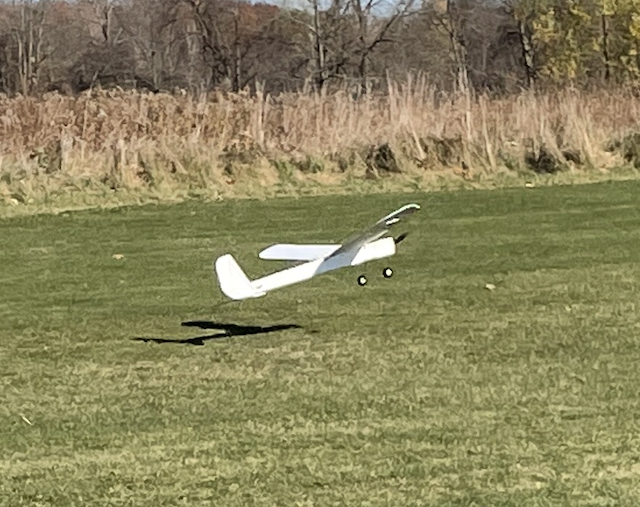 The RUA breaks ground on another successful training flight. We all had a great time on this beautiful fall day at the flying field. More Comments on Flying Field Accidents
Hello Ken, I just had a member get his fingers cut badly by the prop on his electric model plane. He normally flies gas powered planes with an ignition kill switch. However, he does not use anything on his electric models. He had the model on the flight stand and plugged in the LiPo. A gust of wind shifted his model. When he went to grab the model, he bumped the throttle stick to full throttle and the prop cut his finger. I would venture to say that most of our members do not use an arming plug or throttle kill switch on their electric models. I use the FRSKY Taranis Transmitter and have programmed a throttle kill switch on all of my electric models. The switch overrides the throttle channel and sets it to -100%. With the switch activated, the throttle stick has no control of the motor. I activate the kill switch whenever the model is being prepared to fly and after a flight. I leave the switch in the kill position until the model is positioned on the ground and ready to fly. I would like to post an article in our club newsletter that addresses throttle kill (disable) for electric models. Have you addressed this in your newsletters? Can you point me to any discussions on this topic? Thanks, Vic There are several Ampeer issues with information regarding throttle lock setups. KM I attached the article I put in my newsletter, Vic. By Vic Madison Many of our members have recently purchased electric powered airplanes. There are a few items that must be brought to attention regarding safe handling of electric powered models. Here are a few safety items to consider. 1. LiPo battery safety: Most modelers use LiPo batteries for electric power. These batteries should only be discharged down to 3.6 - 3.8 volts per cell. The batteries can be damaged if discharged to less than 3.3 volts per cell. Therefore, the pilot must establish some method to prevent low battery discharge (set a flight timer, use electronic telemetry, fly short duration flights etc.). 2. Once the motor battery is connected to the ESC, the model is LIVE. At this time, any movement of the throttle stick will cause the propeller to turn. If you accidentally bump the throttle stick, the motor will turn the prop. 3. Keep your hands and fingers away from the propeller after the LiPo has been connected to the ESC. VERY IMPORTANT: Some safety method should be established to DISARM the throttle stick until you are ready to fly the model. Here are a few methods: Electronic Kill Switch: Most modern radio/transmitters have the ability to setup one of the transmitter switches as a KILL SWITCH. This is similar to the ignition kill switch used for gas powered models. All transmitter brands will vary regarding 'how' to program it, so whip out the manual and review (but it's not difficult). Use an Arming Plug: An arming plug disconnects the power from the LiPo to the ESC. The motor is disarmed until the plug is inserted. It is mounted in a convenient location on the outside of the model. This allows you to connect the LiPo and close the battery hatch/canopy without arming the motor. Arming Plugs can be purchased from most on-line hobby stores. To start flying, connect the LiPo to the ESC, turn on the transmitter, then plug in the arming plug when you are ready to fly. Mechanical Throttle Restraint: I have seen some modelers connect a rubber band to the throttle stick to hold it in the cutoff position. This would be my least recommended method to disarm the throttle stick. Vic, thanks so much for sharing this with us. Change of Email Address Requested
A reminder for Ampeer subscribers. If you wish to continue receiving the monthly notice, please update your email address whenever you change it. Thanks, Ken Indoor Flying in Brighton Information Indoor flying started at the Legacy Center on Wednesday October 9th. The flying time is 12:30 to 2:30 p.m. The Legacy Center Website is:
Legacy Center, 9299 Goble Dr, Brighton, MI 48116 Indoor Flying in Pontiac Info
Indoor flying in Pontiac started on Tuesday, October 15th and continues on Tuesdays through April 15, 2025. Full Information can be found at the following link.
Join us for indoor flying on Tuesdays throughout the winter! 9AM - 12PM. United Wholesale Mortgage Sports Complex is our host site. Located at 867 South Blvd in Pontiac, the facility features a 365 foot by 260 foot flying area with ceiling heights from 45 to 75 feet! Weekly Indoor Flying is scheduled for Tuesdays from October 15, 2024 thru April 15, 2025 9:00 a.m. to noon. A single flying session is $10 and a 25 session season pass is $150. The Skymasters' Indoor Rules for 2024/2025 are linked here.
As a reminder: 1. Aircraft can weigh no more than 1-1/2 pounds All Up Weight. Helicopters & multi-rotor copters are limited to 250 maximum size. All aircraft must be powered by no more than a single 3 cell (11.1 volt) 1000 mAh battery. 2. First Person View-FPV is limited to micro quadcopters powered by a single cell battery (Max 500 mAh). A quick reminder that indoor flying starts on Tuesday morning (Oct. 15th)! Remember we will be flying up front in the smaller room for the first two weeks. Please still park in the back. Pete 'Tis the Season
No, not THAT season! It is the season of Swap Shops! I received the following email from Joe Hass on the day before putting this issue together. At the Midwest Swap I picked up a Great Planes Giant Ryan STA. Here is the instruction manual. 82" span. 1100 Sq. In. 11 pounds. A scale prop diameter would be 16 to 17" I have a SUNNYSKY x4120-7 550kV available.
With a 6 cell 5000mAh, Castle Talon 90 ESC and a 17 X 6 APC electric. I think I will get good performance. Your thoughts are appreciated. Could go down to a smaller diameter prop. Might also go with 2 packs in parallel to get longer flight time as I think I may need nose weight. Thanks.
First I double checked the specifications and found this information at https://www.flyinggiants.com/forums/showthread.php?t=243055" target=_blank>https://www.flyinggiants.com/forums/showthread.php?t=243055. SPECIFICATIONS
The Specs were slightly different than Joe's info, but not by a lot. The specs on the Webpage seemed to be copied off of the box information. I was also curious about the SunnySky motor specifications, as I had learned over the decades that outrunner brushless motors of about the same weight and Kv have about the same performance. The SunnySky X4120 has a stated weight of 292g/293g and two noted Kv values; 480Kv and 550Kv. I thought that that was interesting, as I'd never seen two Kv values given for the same brushless outrunner before. Once the data was known, it was time to see if the power system, that Joe wanted to use, would work. It had been many, many years since someone had asked me for information to convert a glow to electric. I thought it would be a good time to review this information, especially since some folks might be picking up glow plane bargains at swap shops and converting them to electric power. I found a version of my Glow to Electric xls workbook that I had updated, but never published. I linked the newer version below. When the link is clicked, the workbook/spreadsheet will be downloaded to your downloads file. Look for it there.
The green cells on the spreadsheet are for inputs and the red cells are for the results from running the formulas. Here are the inputs used for Joe's Ryan STA and System Request:  I used the specifications from the online source for the inputs in cells 6 thru 10 and used 150 for the Desired watts in per pound because he likes to fly with lots of power. Cells 12 thru 19 show some results, with the following being the most interesting.  While Joe suggested that he wanted to use a 17x6E, that is a very low diameter to pitch ratio for this type of plane. I input a diameter of 17 into cell 20 and 8 (for the pitch) in cell 21. The following are the results.  Joe noted that he wanted to use a 6S 5000mAh pack with a 90A ESC. 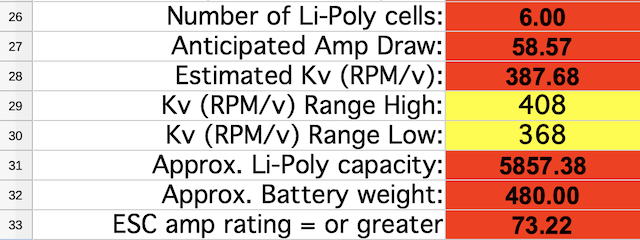 The results, when using a 6S pack and a 17x8E prop, indicated a Kv between 365 & 410 might be appropriate. Previous results indicated that the motor should weigh somewhere between 430g & 680g, yes, that's a big range. All of the results indicated that this particular SunnySky motor was not the one for this particular application. It was too light and its Kv was too high. I emailed Joe and told him that I didn't believe that this power system would work in this application. I also recommended a motor that might be a better choice. How I arrived at that motor is described later. Joe came back with another question, "What combination of prop and cells would make the SunnySky motor work?" I used Lucien Miller's Innov8tive Designs Website to check out motors that might be similar to the SunnySky motor. I found a Cobra motor with similar specs to the SunnySky. It was the Cobra C4120/18. On 6 cells, this motor is rated for up to 1200 watts in. The specification chart indicates that the largest prop that should, or could, be used safely is the 12x8E or 13x4E, depending on your definition of largest. Marginally, a 13x8E or 15x4E. Lucien uses yellow on his chart to note marginal props and says, "The prop can be used, but full throttle should be kept to short bursts." That data confirmed that this motor, on 6S, was the wrong motor for this application. To recommend a motor for Joe's plane I used a different worksheet/spreadsheet titled, "Select-Power-2017-joe.xls". When the link is clicked, the workbook/spreadsheet will be downloaded to your downloads file. Look for it there. This spreadsheet is based on my article, "Selecting Electric Power System, Including Conversions from Glow Planes".
All of the input data is the same as for the previously mentioned workbook titled "2015-glow2electric". This spreadsheet is a bit different from the other one. There is a Review Area that looks like this one.  There is also an area showing the weights of Cobra motors. 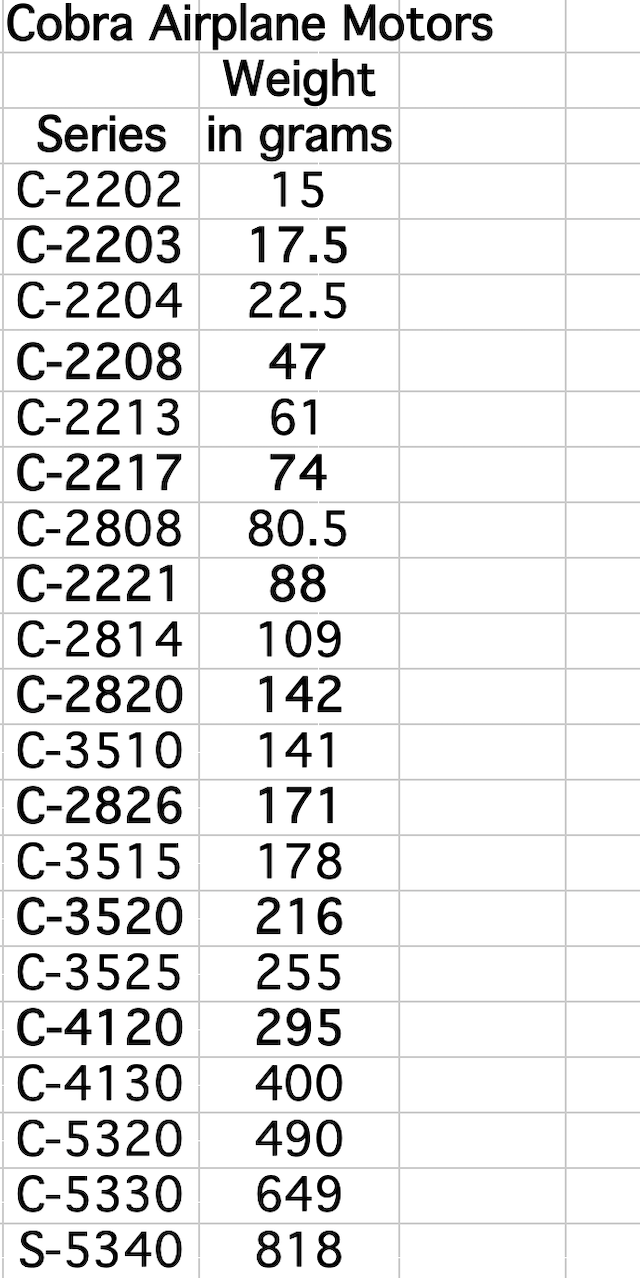 The Review area showed a suggested motor weight range between 433g and 650g. The only input in the Review area of the spreadsheet is for the flight time. That input is for the number of minutes the plane is expected to fly. 8 minutes was chosen. A C-4130 weighs 400g, but the lightest suggested weight is 433g, therefore the C-5320 motors, at 490g were investigated. There are two C-5320 motors. The C-5320/18 with a Kv of 370 and the C-5320/22 with a Kv of 300. Both were investigated for use with a 17x8E prop and 6 cells. The /18 at 22.2V (6S) with a 17x8E prop showed; 52A, 1155 watts in, 6,950 RPM and a 53 mph pitch speed. The data also noted that a 16x10E prop could be used; 53A, 1178 watts in, 6,905 RPM and a 65 mph pitch speed. This would probably be the best prop for this sporty type plane. Only trying both props would actually answer that question. The /22 at 22.2V (6S) with a 17x8E prop shows; 29.7A, 661 watts in, 5,955 RPM and a 41 mph pitch speed The data for the /22 using a 6S pack and 17x8E shows that the power is too low to be usable for this plane at only 661 watts in. The heavier C-5330 motors fall within the weight range, but no suitable diameter prop could be found for use with them on 6S that would result in over 1155 watts in. Actually, any brushless outrunner with a weight of about 490g and a Kv of about 370 should work fine. The data gathered, from the Innov8tive spec chart, using the 17x8 prop with a 6S pack was input into the Work Area of the "Select Power" spreadsheet. A result from this input is shown in the Work Area. 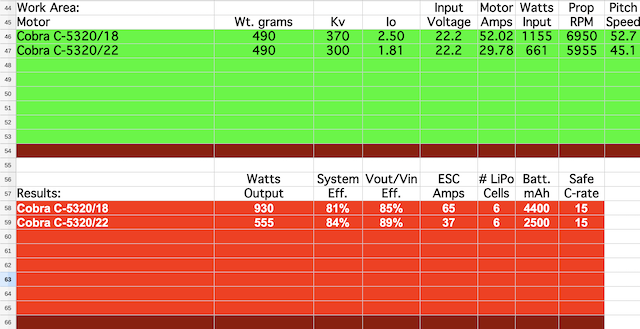 On the day that this article was being put together, I had a phone conversation with Joe. During that conversation, Joe noted that he really likes to use 10 cell packs to keep the amps down by increasing the voltage while keeping the power about the same. I took another look at powering his Giant Ryan STA using 10 cells. I used a copy of the "Glow to Electric xls workbook". All of the inputs were kept the same as for the 6S, but this time the results for 10 cells were viewed. 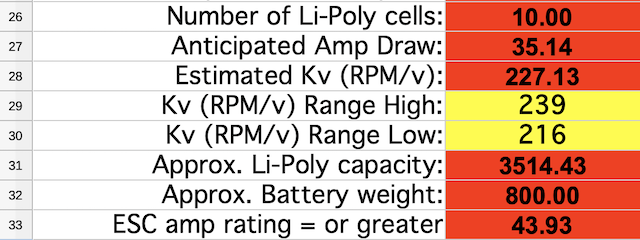 When using 10 cells, the anticipated amp draw dropped from 58.7A for the 6S to 35.14 for the 10S. The motor weight range remained the same, but the Kv range changed to 215 to 240. The "Select Power" worksheet noted that the Cobra C-5330 still fell within the weight range. The Cobra C-5330/18 has a Kv of 250 and the Cobra C-5330/22 has a Kv of 205. Both were close to the suggested 216Kv and 239Kv The results from the "Select Power" spreadsheet for the C-5330 motors and 10S are shown. 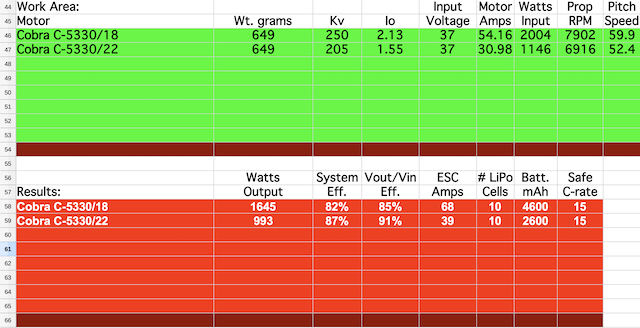 The Cobra C5330/22, or similarly specked motor, would be a good choice for a 10S pack and 17x8E prop. If you, or a flying buddy, pick up a great deal on a glow plane at a local swap shop, you can use these tools to helps you select an electric power system for it. Remember, 'Tis the Season! Friday, April 4 & Saturday, April 5, 2025
Glass City Center - Main Floor
Admission: $10 Toledo RC Swap Meet Website
Manufactures, Distributors, and Businesses Welcome! Questions Contact:
request info at: info@toledorcswapmeet.com To Reach Ken Myers, you can land mail to the address at the top of the page. My E-mail address is: KMyersEFO@theampeer.org |

